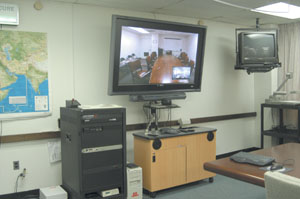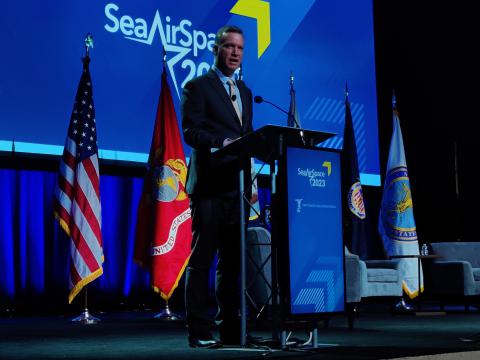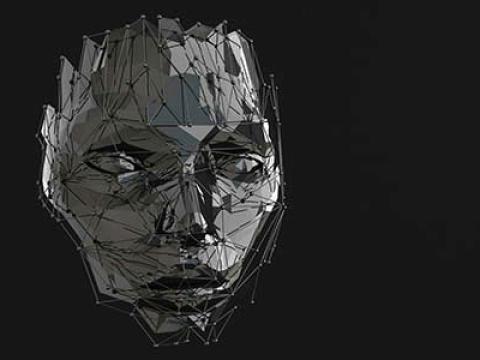System Protects Video Communications
Agencies flip the switch on secure videoconferencing. 
Office of Naval Research personnel use the Integrated Secure Encryption Console, developed by CritiCom, to converse with senior advisers involved in military operations. A large sign mounted above the equipment displays “secure” versus “nonsecure” when a videoconferencing session is in a classified mode.
Demands to increase information sharing and collaboration among government agencies are creating a growing requirement for easy-to-use security products that facilitate classified communications. Many organizations are now realizing the benefits of videoconferencing; however, information protection in this area generally involves support from communications security-certified personnel, and moving from unclassified to classified conferences requires cumbersome procedures.
To address these impediments, a fiber optic security switch system has been developed that enables both secure and nonsecure video communications through a single conferencing system. This technology is helping one of the U.S. Navy’s lead research organizations collaborate with senior advisers and warfighters in current theaters of operations to get new systems into the field faster.
The Office of Naval Research (ONR), Arlington, Virginia, which specializes in developing new capabilities for the Navy and U.S. Marine Corps, made do with basic secure videoconferencing equipment prior to purchasing a more advanced system built around a fiber optic switch. While the previous system allowed for secure desktop video communications, it could not accommodate presentations for large groups and at times was unreliable.
Recognizing that a more robust, easier-to-use secure videoconferencing capability was critical for carrying out its mission, the ONR purchased the Integrated Secure Encryption Console (ISEC) system developed by CritiCom, Lanham, Maryland. The ISEC switch protects classified communications to the levels above Top Secret. The system includes an optical dial isolator that enables users to dial a telephone number either on screen or by remote control.
Although secure video communications equipment currently is available, other products require a certified technician to physically change and remove cables to switch between secure and nonsecure environments. The ISEC equipment remedies this problem by allowing videoconferencing participants to move between the two environments using a toggle.
According to a study conducted by Wainhouse Research, Brookline, Massachusetts, and sponsored by Criticom, the transmission of voice, video and data during videoconferences is one of the most prevalent areas of security concerns. Many government agencies are not complying with National Security Agency regulations because of the high cost and complexity of the necessary equipment.
Properly securing videoconferences entails ensuring protection in three areas: data storage, data radiation and data encryption. Unless data shared during a videoconference is stored securely, it can be accessed by unauthorized personnel. Confidential information also can be electrically radiated by conferencing equipment. As a result, transmissions can be monitored or intercepted. The Wainhouse report states that signals radiating from a video monitor can be picked up from nearly 1 mile away. According to the Federation of American Scientists, this would allow a person to view all of the contents of a computer monitor from more than a half a mile away without being detected.
Criticom offers different ISEC models that address these security concerns. Users can integrate the ISEC-320 model with existing videoconferencing equipment. The switch has been certified by the Defense Information Systems Agency Joint Interoperability Test Command and is Tempest-approved for classified transmissions. Housed in a secure cabinet, the equipment allows users to move between secure and nonsecure H.320 communications by flipping a tabletop switch. The system includes network termination equipment, an inverse multiplexer, a secure/nonsecure signal switching module and an encryption signal isolation capability. Based on emissions tests conducted by the U.S. Air Force, the ISEC-320 can be used to process classified video in facilities with zone ratings of A, B, C or D.
The ISEC-STS, a self-contained videoconferencing unit, includes the security features of the ISEC-320 integrated with compression/decompression module technology offered by Tandberg Television, Southampton, United Kingdom. Users can place a secure videoconference call using a stored telephone book, and the system handles all dialing, control and circuit routing functions necessary to encrypt and isolate classified data. The system includes a plasma display screen in sizes that range from 42 inches to 60 inches. Encryption is available for users who connect via an Internet protocol intranet.
The company’s newest addition to its product line is the ISEC-STS–Deployable. The portable system features the same fiber optic technology for Type 1 security, enabling classified communications to levels above Top Secret. Housed in a single container that is approximately the size of a large dishwasher, the standard system features a 17-inch liquid crystal display panel, the Tandberg 2500 system, a Tempest-certified fiber optic switch, a camera and speakers, a push-to-talk microphone, and a secure mode switch. Users can transmit live video feeds from both outdoor and indoor locations worldwide. The equipment is compatible with terrestrial integrated services digital network circuits as well as satellite terminals such as the Inmarsat M4. It features an access patch panel to connect to external displays and audio peripherals so it can be connected to a full-size conference room system.
The ONR has been using the ISEC-320 for a little more than a year. Stewart Bowers, lead audio-visual specialist, ONR, says the office’s personnel have employed the equipment to make presentations to senior advisers in the current theaters of operations, to ships at sea and to acquisition program managers. Primarily, videoconference discussions have centered on new equipment that the ONR is developing, including weapons systems.
“This effort really came about after 9/11. In an effort to get the best equipment out to the field in the shortest period of time, developers wanted to know from the people in the field if the new equipment would help them do their jobs better. It is enhancing communications with ONR’s customer base,” Bowers explains. The ONR intends to purchase additional equipment for its new facility, which will feature an entire level that is a sensitive compartmented information facility, he adds.
Robert Winegard, executive vice president, CritiCom, says that the development of the ISEC product line was influenced in part by the status of security in many agencies. After September 11, 2001, many organizations that did not place high priority on security prior to the terrorist attacks had to examine and improve their procedures. However, agencies that were not traditionally involved in security processes lacked personnel who knew what was involved in securing communications. This revealed the need for products that are easy to use yet provide the required levels of security. “Our product was designed to make videoconferencing secure in the correct way but also make it easy so anyone can use it. It’s basically shrink-wrapped security,” Winegard says.
The company’s customers include organizations throughout the U.S. Defense Department as well as the White House and the U.S. Department of Homeland Security. Members of the 5th Army are using the ISEC-STS–Deployable in current operations both in garrison and in the field.
However, Winegard points out that, as other agencies are being called upon to share information and to collaborate, interest in secure videoconferencing is increasing. For example, because of the projects it directs as well as security concerns, Johns Hopkins University currently has three conferencing rooms that require Type 1 encryption communications capabilities. “We’re seeing brand new customers such as the Food and Drug Administration because it now needs a secure videoconferencing environment,” he says.
Orders for the company’s products illustrate this growing interest in secure videoconferencing. Although CritiCom had sold only 45 ISEC units as of early this summer, it had a backlog of orders for 200 units. “There are going to be some people who don’t need to conference face to face. But in the military, a commander wants to see what’s on [the officers’] faces so he’s sure they understand and agree with the orders,” Winegard notes.
Web Resources
CritiCom: www.criticom.com
Office of Naval Research: www.onr.navy.mil
Tactical Video Teleconferencing Laboratory: http://jitc.fhu.disa.mil/vtc/technical.htm
Technology Defined: www.technologydefined.com/teleconferencing




